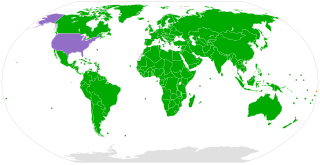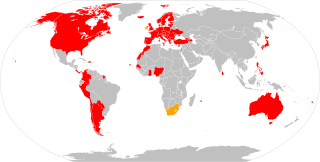
A treaty is a formal, legally binding written contract between actors in international law. It is usually made by and between sovereign states, but can include international organizations, individuals, business entities, and other legal persons.

The United Nations Convention on the Rights of the Child is an international human rights treaty which sets out the civil, political, economic, social, health and cultural rights of children. The convention defines a child as any human being under the age of eighteen, unless the age of majority is attained earlier under national legislation.
The Protocol for the Prohibition of the Use in War of Asphyxiating, Poisonous or other Gases, and of Bacteriological Methods of Warfare, usually called the Geneva Protocol, is a treaty prohibiting the use of chemical and biological weapons in international armed conflicts. It was signed at Geneva on 17 June 1925 and entered into force on 8 February 1928. It was registered in League of Nations Treaty Series on 7 September 1929. The Geneva Protocol is a protocol to the Convention for the Supervision of the International Trade in Arms and Ammunition and in Implements of War signed on the same date, and followed the Hague Conventions of 1899 and 1907.

The Convention for the Suppression of the Traffic in Persons and of the Exploitation of the Prostitution of Others was approved by the United Nations General Assembly on 2 December 1949, and entered into force on 25 July 1951. The preamble states:
"Whereas prostitution and the accompanying evil of the traffic in persons for the purpose of prostitution are incompatible with the dignity and worth of the human person and endanger the welfare of the individual, the family, and the community"
The 1972 Protocol amending the Single Convention on Narcotic Drugs was a protocol that made several changes to the Single Convention on Narcotic Drugs. It highlighted the need for treatment and rehabilitation of drug addicts, instructing parties to take "all practicable measures for the prevention of abuse of psychotropic substances and for the early identification, treatment, education, after-care, rehabilitation, and social reintegration of the persons involved". It also expanded the International Narcotics Control Board from 11 members to 13 members.

The Protocol Amending the Agreements, Conventions and Protocols on Narcotic Drugs concluded at The Hague on 23 January 1912, at Geneva on 11 February 1925 and 19 February 1925, and 13 July 1931, at Bangkok on 27 November 1931 and at Geneva on 26 June 1936 was a treaty, signed on 11 December 1946 at Lake Success, that shifted the drug control functions previously assigned to the League of Nations to the United Nations. As the Protocol's official title says, it modifies the provisions of the:
The Protocol to Prevent, Suppress and Punish Trafficking in Persons, Especially Women and Children is a protocol to the United Nations Convention Against Transnational Organized Crime. It is one of the three Palermo protocols, the others being the Protocol Against the Smuggling of Migrants by Land, Sea and Air and the Protocol Against the Illicit Manufacturing of and Trafficking in Firearms.

The 1926 Slavery Convention or the Convention to Suppress the Slave Trade and Slavery is an international treaty created under the auspices of the League of Nations and first signed on 25 September 1926. It was registered in League of Nations Treaty Series on 9 March 1927, the same day it went into effect. The objective of the convention is to confirm and advance the suppression of slavery and the slave trade and was extended in 1956 with the Supplementary Convention on the Abolition of Slavery, under the auspices of the United Nations.

An International Driving Permit (IDP), often referred to as an international driving license, is a translation of a domestic driving license that allows the holder to drive a private motor vehicle in any country or jurisdiction that recognises the document. The term International Driving Permit was first mentioned in the document prescribed in the International Convention relative to Motor Traffic that was signed at Paris in 1926, and is a translation of the French 'permis de conduire international', or 'international driving license'. The Paris treaty, and all subsequent, use the word 'permit' exclusively in relation to all kinds of driving license.

The Convention on Cybercrime, also known as the Budapest Convention on Cybercrime or the Budapest Convention, is the first international treaty seeking to address Internet and computer crime (cybercrime) by harmonizing national laws, improving investigative techniques, and increasing cooperation among nations. It was drawn up by the Council of Europe in Strasbourg, France, with the active participation of the Council of Europe's observer states Canada, Japan, the Philippines, South Africa and the United States.

The Convention on Road Traffic, commonly known as the Geneva Convention on Road Traffic, is an international treaty promoting the development and safety of international road traffic by establishing certain uniform rules among the contracting parties. The convention addresses minimum mechanical and safety equipment needed to be on board and defines an identification mark to identify the origin of the vehicle. The Convention was prepared and opened for signature by the United Nations Conference on Road and Motor Transport held at Geneva from 23 August to 19 September 1949. It came into force on 26 March 1952. This conference also produced the Protocol on Road Signs and Signals.
The International Convention for the Suppression of the Traffic in Women and Children is a 1921 multilateral treaty of the League of Nations that addressed the problem of international trafficking of women and children.
The International Agreement for the suppression of the White Slave Traffic is a series of anti–human trafficking treaties, specifically aimed at the illegal trade of white humans, the first of which was first negotiated in Paris in 1904. It was one of the first multilateral treaties to address issues of slavery and human trafficking. The convention held that human trafficking was a punishable crime and that the 12 signatories should exchange information regarding human trafficking operations.
The Agreement for the Suppression of the Circulation of Obscene Publications is a multilateral anti-pornography treaty that was initially negotiated and concluded in Paris in 1910. It was amended by a 1949 Protocol. As of 2013, the treaty has 57 state parties.
The Hague Hijacking Convention is a multilateral treaty by which states agree to prohibit and punish aircraft hijacking. The convention does not apply to customs, law enforcement or military aircraft, thus it applies exclusively to civilian aircraft. The convention only addresses situations in which an aircraft takes off or lands in a place different from its country of registration. The convention sets out the principle of aut dedere aut judicare—that a party to the treaty must prosecute an aircraft hijacker if no other state requests his or her extradition for prosecution of the same crime.
The Convention for the Suppression of Unlawful Acts against the Safety of Civil Aviation is a multilateral treaty by which states agree to prohibit and punish behaviour which may threaten the safety of civil aviation.
The Beijing Convention is a 2010 treaty by which state parties agree to criminalise certain terrorist actions against civil aviation.
The International Convention for the Suppression of Counterfeiting Currency is a 1929 League of Nations treaty whereby states agree to criminalize acts of currency counterfeiting. It remains the principal international agreement on currency counterfeiting.